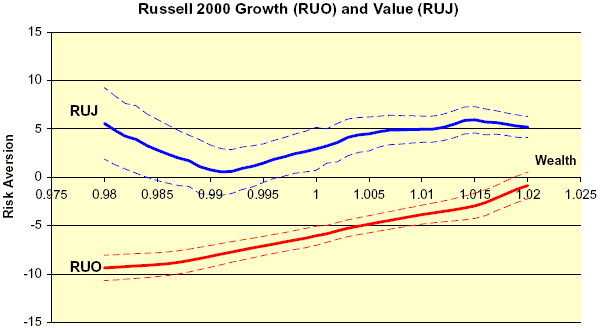Are value (growth) investors stolid conservatives (wild risk-takers)? If so, is there a way to trade on the difference in behavioral preferences? In their September 2006 paper entitled “Risk Aversion and Clientele Effects”, Douglas Blackburn, William Goetzmann and Andrey Ukhov compare the risk preferences of value and growth investors by examining: (1) option prices for pairs of value-growth indexes, and (2) funds flows for value and growth mutual funds. They further investigate whether any profitable options trading strategies devolve from the difference in risk preferences. Using recent data for five value-growth index pairs and for several value and growth mutual funds, they find that:
- Value investors avoid risk, while growth investors seek it. (See the chart below, for example.)
- Risk preferences of value investors are more persistent than those of growth investors, suggesting that value investors are less likely to chase returns.
- Value-growth switchers react to past returns of the styles, and to changes in risks (volatilities) of the styles.
- Trading strategies that sell near-term options in growth indexes, buy near-term options in value indexes and hold to expiration generate positive returns. Growth investors in aggregate will pay more for options than will value investors.
The following graph, taken from the paper, depicts the inferred risk aversions of investors in stocks of the Russell 2000 Growth Index (RUO) and the Russell 2000 Value Index over the period December 2003 through July 2005. The horizontal axis (“Wealth”) indicates the monthly returns for the indexes, with levels of 0.98, 1 and 1.02 corresponding to returns of -2%, 0% and +2%, respectively. The dashed lines indicate bounds of one standard deviation around the mean risk aversions. The graph indicates that value investors (RUJ) are more risk averse than growth investors (RUO) regardless of past returns.

In summary, value investors are generally risk avoiders, and growth investors are typically risk seekers. Buying risk from one group and selling it to the other may be profitable.